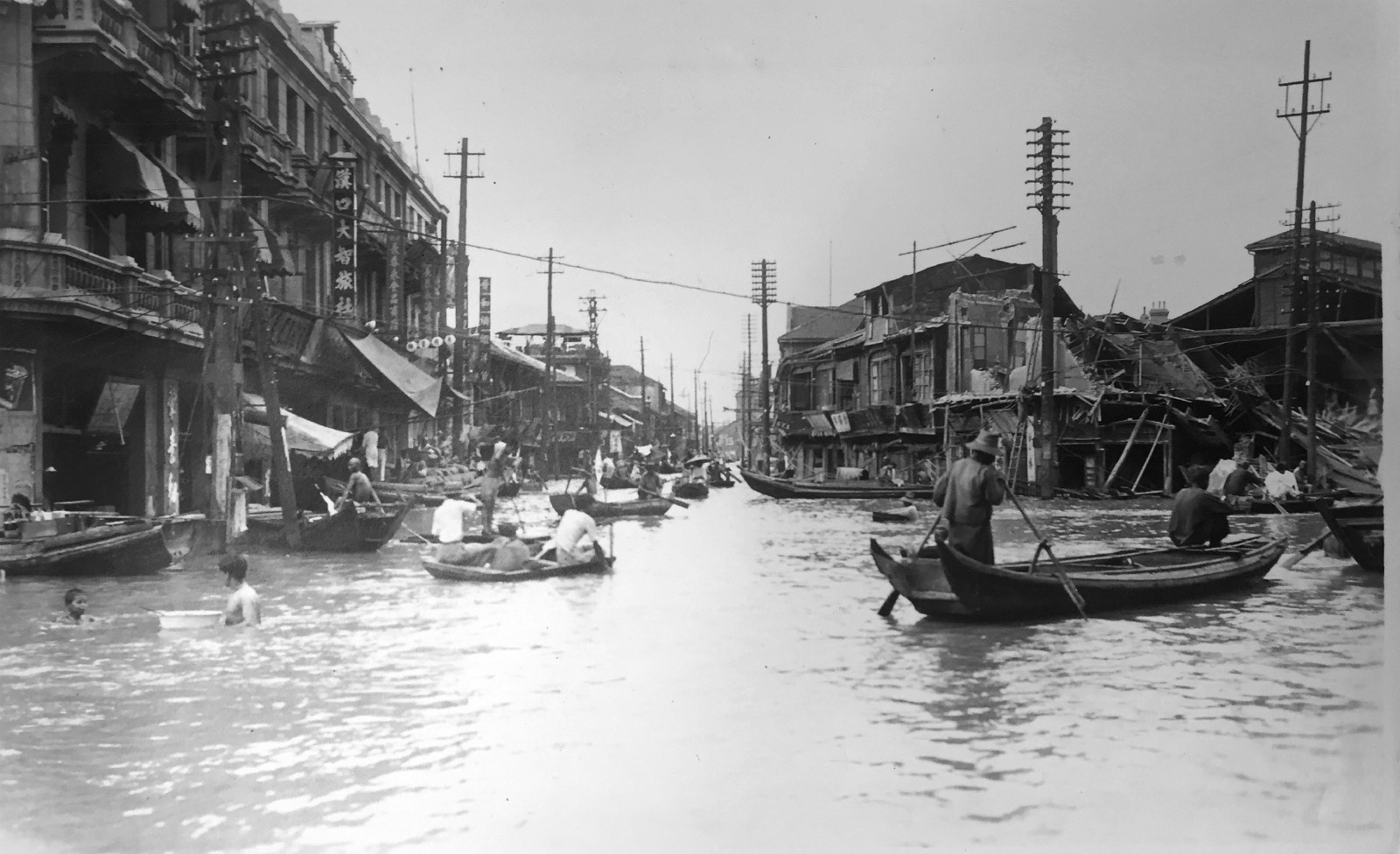This Week in China’s History: August 26, 1931
The floods that have devastated swathes of central China this summer remind us — not that there is often time to forget — that flood control has been a priority of Chinese governments for many centuries. Just like 2019, 2017, 2016, and 2010 — to give some recent examples — this year’s floods have affected millions of people across China.
This week, we look back to 1931, when maybe the worst of these floods inundated an area the size of New England across central China, affecting perhaps 50 million people.
As with most floods of this scale, it is difficult to pinpoint a moment when it turned disastrous. The flooding itself lasted for months, from June through at least October, depending on the specific place, and of course the destruction and consequences lasted much longer than that. But August 25 to 26 was an exclamation point on months of disaster, the moment when as many as 15,000 people died when the levees around the city of Gaoyou broke.
Even before the Gaoyou dike breach, though, a lake 900 miles long and 40 miles wide engulfed central China. Historian Chris Courtney painted a picture of the transformed country in his award-winning 2019 book, The Nature of Disaster in China: “In urban areas, a noxious cocktail of water was running through the streets, contaminated with animal carcasses, industrial chemicals, and human waste. Outside of cities…a vast expanse of clear green water, its surface broken by the treetops and the roofs of houses.”
The most visible cause of the floods — in 1931 and in 2020 — was rain. Courtney describes the spring of 1931 as “one continuous deluge” that dropped a year and a half’s worth of rain in just one month. And this followed an unusually cold and snowy winter in the mountains, locking in a dense snowpack whose melt added to the torrent. By June, water was already forcing people from their homes; the Yangtze was at record levels.
But while nature was an essential element in the floods, it was not the only factor. The transformation of the Yangtze basin took place over millennia. The Yangtze is not only one of the earth’s longest rivers, it is a site of tremendous biodiversity. Zoologist Anthony Turvey, who has written compellingly about the extinction of the Yangtze River dolphin, called the ancient Yangtze the “Amazon of the East,” the center of an ecosystem of marshes, lakes, and tributaries, in addition to the grand mainstem. Nourished by regular flooding, the river system of south-central China was one of the earth’s most prolific.
By the early 20th century, human activity had reshaped the plains of Hubei, Hunan, Jiangsu, and surrounding provinces so that the floods were now catastrophes rather than essential routines. Dikes, canals, and polders regulated the flow of water, protecting cities and irrigating farmland. While effective in their mission, the new hydraulic infrastructure required maintenance, without which the normal function of the river resumed, now to devastating effect. Marshes helped absorb floodwaters in the past, but over time they were eliminated in favor of more “productive” uses for land. The overwhelming volume of the 1931 rains and snowmelt would have caused flooding even without a human presence, but the constrained and domesticated natural networks stood no chance against the inundation, and in many cases made it worse.
Many of the lakes, rivers, and canals in the Yangtze basin had by the 20th century become “suspended”: levees built to prevent flooding enable silt to raise the bottom of a lake or river. This in turn raises the surface level, leading to higher levees, leading to more silt, and still higher levees. Over time, the lake or riverbed can become higher than the surrounding plains. If the levee breaks, the entire volume of the suspended lake seeks its level by claiming the entire surrounding plain. (This has happened regularly since ancient times on the Yellow River, a process described ably by Micah Muscolino in his book on the 1937 Yellow River floods.)
The August 26 Gaoyou flood combined these natural and artificial elements. The Gaoyou region, about 125 miles northwest of Shanghai, was full of features intended to manage water for farming and transportation. The Grand Canal ran by the city — the segment there predated the formal “Grand Canal” title and construction by a millennium — and connected a series of lakes that had become part of the canal system. Both the canal and Gaoyou’s artificial lake were suspended several meters above the surrounding plain, as was the even larger Hongze Lake a few miles away.
To the flooding that had begun in June and the precarious state of the hydraulic infrastructure was now added a final disastrous piece. A typhoon moved inland over Shanghai on August 24, bringing 100 mph winds as it passed the weather station at the Jesuit mission in Siccawei. As the storm moved northwest, raising whitecaps on the lakes of Jiangsu, high winds, heavy rains, and wave action stirred the colossal volume of water that had been building for months. After dark on August 25, numerous breaches opened above the city of Gaoyou, the widest being more than 1,500 feet wide. Water surged into the city.
Estimates are that between 10,000 and 15,000 people drowned that night in Gaoyou. When the floodwaters eventually receded, in December, a team led by engineer Wang Shuxiang and Presbyterian missionary Lyt Harnsberger, and funded in part by a Buddhist hermit, oversaw the reconstruction of dikes in Jiangsu.
Besides the inundation of Gaoyou, the face of the flood was a now-familiar focus of disaster: Wuhan. The city’s long history of floods — one that continues into the summer of 2020–had led to the construction of a temple to the Dragon King–Chris Courtney describes him as “an environmental bureaucrat”–sitting at the confluence of the Yangtze and the Han. The temple to the Dragon King had been protecting Wuhan (or the three cities that comprised the metropolis) since at least the 1730s.
But the Dragon King was not there to ward off the floodwaters in 1931: the government had torn down the temple a year earlier, part of a campaign against superstition. Whether the 1931 floods owed more to the state’s neglect of riverine infrastructure or to the hubristic dismissal of local gods, I will leave to others. The government had planned an extensive program for renovating the flood defenses, as historian David Pietz has described, but the plans came too late for the more than 400,000 Wuhan residents rendered homeless.
The destruction of the 1931 floods cannot be reduced to statistics, but the numbers are nonetheless staggering. Perhaps 150,000 people drowned, and as many as two million people died, most of them from flood-related diseases like cholera, malaria, and schistosomiasis. Economically, the flood wiped out years of income for many, and exacerbated inequalities as families with means acquired the assets of poor families desperate for any relief. These socio-economic shifts furthered the fortunes of the communist movement, then just a decade old. Fearing communist sympathizers, the government drove many refugees trying to return home back into camps where disease was rampant, increasing antipathy toward the Republic. The cost of rebuilding shaped the Republic’s budget and spending at a time when it was trying to gain its footing after the Northern Expedition to reunify the country and the relocation of the capital to Nanjing (itself inundated by floodwaters in 1931).
This year’s Yangtze floods are just one of many catastrophes in 2020, but we would do well to remember the 1931 floods as we consider our society’s responses to large-scale disasters. As with the 1931 floods, the COVID-19 pandemic had a natural origin, but also as in 1931, human activity shaped the course and effects of the disaster. And as in 1931, the effects and consequences of the event played out over a long period of time in often unexpected ways.
This Week in China’s History is a weekly column.






